The Chunky Sneaker Market is estimated to be valued at USD 50.5 billion in 2025 and is projected to reach USD 78.4 billion by 2035, registering a compound annual growth rate (CAGR) of 4.5% over the forecast period.
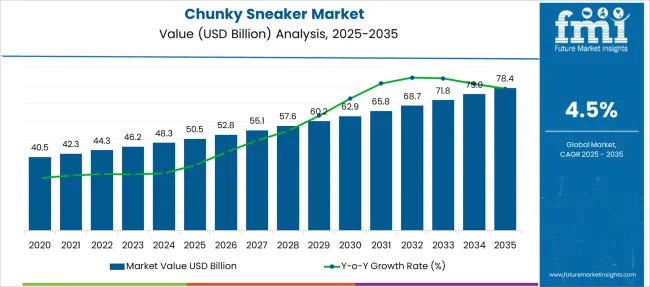
| Metric | Value |
|---|---|
| Chunky Sneaker Market Estimated Value in (2025 E) | USD 50.5 billion |
| Chunky Sneaker Market Forecast Value in (2035 F) | USD 78.4 billion |
| Forecast CAGR (2025 to 2035) | 4.5% |
The Chunky Sneaker market is experiencing steady growth as consumer preferences shift toward bold, fashion-forward footwear that merges style with functionality. Influenced by streetwear culture, social media trends, and celebrity endorsements, these sneakers have become a staple in urban and casual fashion wardrobes. Recent brand announcements and fashion house statements confirm that chunky silhouettes continue to dominate seasonal collections, especially in global fashion capitals.
Additionally, rising demand among younger demographics, combined with the integration of performance materials and sustainable production techniques, is reshaping product design and expanding market appeal. Footwear innovation focused on comfort and orthopedic support is also contributing to market growth, particularly in regions where long-duration wear is common.
As retailers focus on omnichannel strategies and limited-edition drops, the market is expected to maintain upward momentum With growing awareness around individuality, customization, and inclusive sizing, chunky sneakers are anticipated to remain a relevant and profitable category across diverse consumer segments in the years ahead.
The market is segmented by Type, Waterproofing, Consumer Orientation, and Price Range and region. By Type, the market is divided into Road, Treadmill, Trail, Mud, and Snow. In terms of Waterproofing, the market is classified into Waterproof and Water Repellent. Based on Consumer Orientation, the market is segmented into Men, Women, and Kid. By Price Range, the market is divided into USD 20 to USD 50, Below USD 20, USD 50 to USD 100, and Above USD 100. Regionally, the market is classified into North America, Latin America, Western Europe, Eastern Europe, Balkan & Baltic Countries, Russia & Belarus, Central Asia, East Asia, South Asia & Pacific, and the Middle East & Africa.
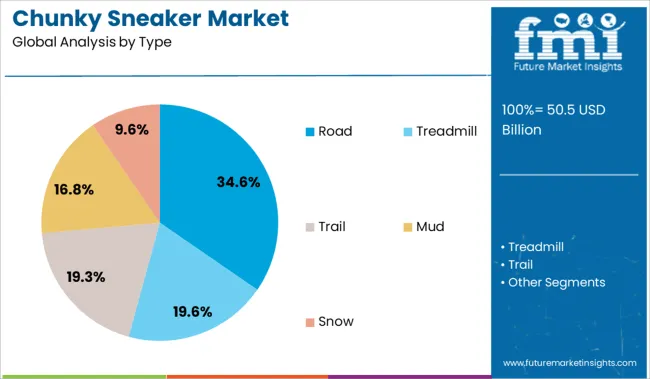
The road segment is projected to account for 34.6% of the Chunky Sneaker market revenue share in 2025, making it the leading segment by type. This dominance is being driven by the widespread preference for versatile sneakers that offer daily wear performance across urban settings. Brand releases and retail data suggest that road-type chunky sneakers are being favored for their balance of fashion aesthetics and practical design, making them suitable for commuting, casual outings, and everyday use.
Their ability to pair with various outfits, from streetwear to semi-formal attire, has elevated their appeal among consumers seeking both style and functionality. Enhanced cushioning, arch support, and breathable materials are being integrated to meet comfort expectations while retaining bold design elements.
These factors, supported by promotional strategies focused on lifestyle imagery, are positioning road-type chunky sneakers as a staple category across mainstream and premium footwear brands Their accessibility, coupled with ongoing design innovation, continues to secure their leading position in the market.
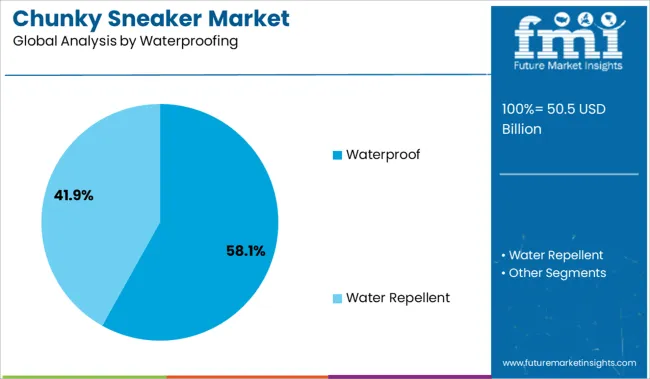
The waterproof segment is expected to contribute 58.1% of the Chunky Sneaker market revenue share in 2025, establishing itself as the top-performing subsegment under waterproofing. This growth is being influenced by increasing consumer demand for sneakers that withstand varying weather conditions without compromising on aesthetics. Recent product rollouts and materials innovation announcements have emphasized the incorporation of waterproof membranes and hydrophobic coatings in chunky sneaker designs.
This has led to wider acceptance of waterproof variants in urban markets that face frequent rainfall or fluctuating climates. The segment’s momentum is also being driven by outdoor enthusiasts and travelers who seek all-season wearability without sacrificing comfort or trend appeal. Brands are leveraging technology to deliver waterproof features without adding bulk, preserving the signature chunky silhouette.
Consumer sentiment has shown strong alignment with durability and low-maintenance functionality, both of which are central to this segment As weather-adaptive fashion gains popularity, waterproof chunky sneakers are expected to retain a strong foothold in the global market.
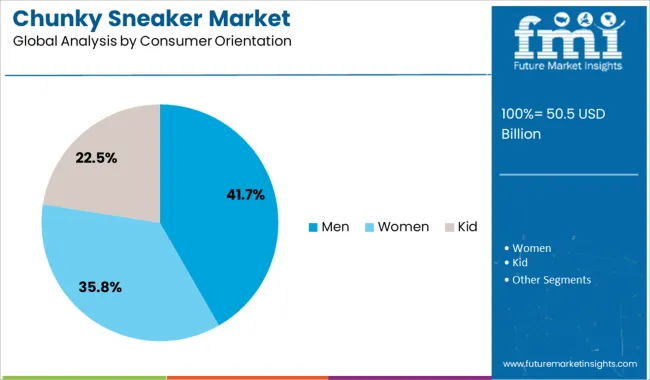
The men segment is forecasted to account for 41.7% of the Chunky Sneaker market revenue share in 2025, maintaining its leadership in consumer orientation. This segment’s growth is being supported by heightened interest in statement footwear among male consumers, especially in the athleisure and streetwear spaces. Brand campaigns and fashion commentary have highlighted a significant increase in male-targeted releases, often featuring oversized soles, futuristic textures, and limited-edition collaborations.
The segment benefits from high engagement across e-commerce platforms, with men increasingly purchasing sneakers that reflect personality and lifestyle. Product lines catering to male consumers often emphasize performance features, durability, and bold aesthetics, aligning with market expectations. Additionally, collaborations with sports icons, musicians, and fashion influencers have enhanced visibility and desirability in this demographic.
Retail insights confirm that men are showing greater willingness to invest in premium footwear that merges trend with function These factors collectively support the sustained leadership of the men segment in the chunky sneaker category.
A more retro-inspired variety has replaced the more conventional breed of chunky sneakers that were popular in the past and had expanded elements such as a big rubber sole in 2025. For true fashion aficionados, chunky shoes are now a must-have item. This type of footwear sometimes referred to as chunky sneakers, ugly sneakers, or turbo trainers, is now popular. The first is that, despite being a high-end fashion house, Dad Shoes are most frequently linked with the brand Balenciaga.
That's a result of one specific product it makes, which we'll examine in more detail in a moment. Remember that Yeezy is an Adidas brand even if Nike is listed as the following item on the list, so the third and fourth positions can be combined. Yeezy and Balenciaga have the highest share of voice among the top five cities for dad shoe mentions: New York, London, Los Angeles, Paris, and Detroit.
Over the past several years, there has been a growth in demand for Chunky Sneakers because outdoor activities are becoming more and more popular. Along with increased disposable income and a preference for physical fitness, this factor is likely to boost the global chunky sneaker market during the course of the anticipated timeframe.
Good, chunky sneakers are the epitome of comfort. However, there are some compelling arguments for and against them when considering them as a trend. The opposing side argues that there are elites who could create literature on bulky sneakers. They are referred to by one segment of society as simply casual dad shoes and by another as the next big thing in fashion. Regardless of the ongoing argument, these adaptable clunky sneakers have made a significant reappearance this year.
It's interesting to note that they were commonplace twenty years ago before abruptly going away. They were only occasionally visible in the fashion world. They were valued more for their use in the great outdoors than for their aesthetic appeal. They rose through the ranks throughout time, gradually but surely, and are currently regarded as a huge trend for 2025.
Even while the bulk of buyers, whether sneakerheads or not, will always prefer simple silhouette trainers, millennials' need to separate out has grown. The use of social media has increased the value placed on looking different and being unique. We now have sneakers with mismatched colors, greater chunkiness, and more ugliness as a result of manufacturers seeing this shift in customer behavior when buying streetwear.
Whether they are aware of it or not, customers who are more likely to purchase these clunky trainers are certainly wanting to make a statement. Sneaker soles have gotten chunkier over the past year, along with brighter colors and more attention to detail. Consider the Balenciaga Triple S, a hefty shoe with three sole sections piled on top of each other that quickly gained attention from sneakerheads and on social media.
Since the chunky sneaker trend has returned, we have seen a sharp rise in the number of people in major cities around the world who are actually buying into the hype. As the trend grows, so does the demand. Due to the need, numerous brands have contributed to the creation of their own inventive chunky sneakers. More will be produced when more consumers make purchases. My friends, it's all about supply and demand.
A sustainable choice for sneakers was long overdue, given the negative effects the fashion industry has on the environment. Leading sports companies like Puma, Nike, and Adidas have made purposeful decisions to produce environmentally friendly sneakers. These Sneakers are made with vegan leather that contains little PVC. Even locally grown algae were used by brands like Yeezy to create their most recent Foam Runner line.
The initial measures have been done by the brands to reduce greenhouse gas emissions, and women around the world are grateful for this admirable deed. The Veja Campo from Arket, the Star Master from Novesta, the Boost 700 from Adidas Yeezy, and the Vegan Leather Sneakers from Stella McCartney are some of the most well-liked options. These eco-friendly sneakers are gorgeous.
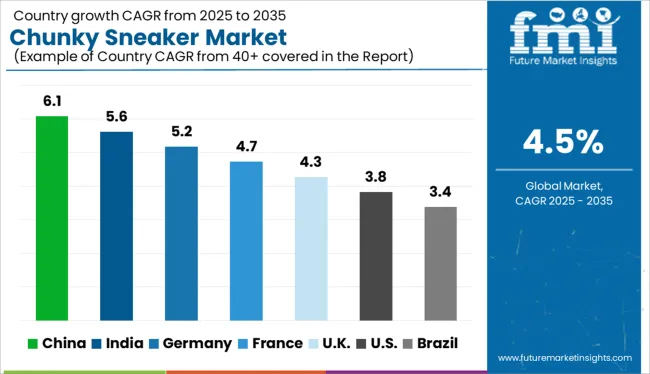
Chunky Sneaker Market First Originated in the USA.
Although the chunky sneaker craze may have originated in the USA, other nations quickly adopted their own renditions during the 1990s. The Espresso, a cult shoe from the Japanese brand Northwave that was inspired by snowboard boots from the 1980s, was their response. The sneaker has long been a favourite on the Harajuku streets and was even mentioned in Sneaker Tokyo Vol. 2 by Hiroshi Fujiwara.
Everlane is the American Company that launch a project on Sustainable Chunky Sneaker or Dad shoe Market.
After promising to stop using virgin plastic, Everlane's newest endeavour is a pair of extremely sustainable sneakers. But it's more than just a meagre shoe. It's a full concept and idea, Everlane's CEO Michael Preysman said in an interview with GQ. The website for the company has a different area dedicated to Tread, the new sneaker line. This shoe is a beautiful slightly hefty, but not overly so, unisex normcore sneaker for individuals who are primarily concerned with aesthetics.
It is available in a variety of neutral tones as well as subdued pink and yellow hues. The excitement around this sneaker, however, is more about its construction than its appearance. This sneaker took two years to create, and Everlane wants you to know what went into it. I'm continually impressed by Everlane's dedication to environmental sustainability, and these chunky sneakers are no exception. These sneakers have a carbon footprint that is entirely offset and are constructed from 100% Vietnamese leather, recycled rubber, and natural rubber.
The road is the most preferred Game type in the Chunky Sneaker Market
Road running footwear is made for pavement and brief excursions onto compacted terrain with minor imperfections. They are designed to cushion or balance feet during prolonged strides on hard, even surfaces and are light and flexible. The best for runners who use the road, treadmills, or tracks. Road running footwear has a smoother, flatter sole to provide a constant running surface on paved roads.
Waterproof leads the Chunky Sneaker Market
Running shoes will never be completely waterproof, of course. The opening around the ankle can let raindrops and puddles into your shoe, but with the correct running shoes, this risk can be reduced. Running shoes with trustworthy waterproofing can significantly improve your runs.
Due to its consistent moisture protection and breathability, Gore-Tex is one of the most popular waterproof membranes, but there are countless alternative options that are effective as well. You may choose a pair of waterproof running shoes that are appropriate for your foot type, running style, and preferred terrain thanks to the large selection available. The choices on this list were chosen after extensive study, user review analysis, and expertise of the market.
The male is the most prominent category
Every man's shoe collection must include a pair of running shoes. In actuality, the more pairs there are, the better. Since it is a year-round activity, it is always advisable and enjoyable to choose pairs that offer the greatest level of comfort, is portable and strong, look fashionable, and so on. And to be honest, for a lot of us, a nice pair of shoes serves as a form of inspiration to get out of bed each day and achieve a goal. Having said that, it is undeniably difficult to select the ideal pair of shoes.
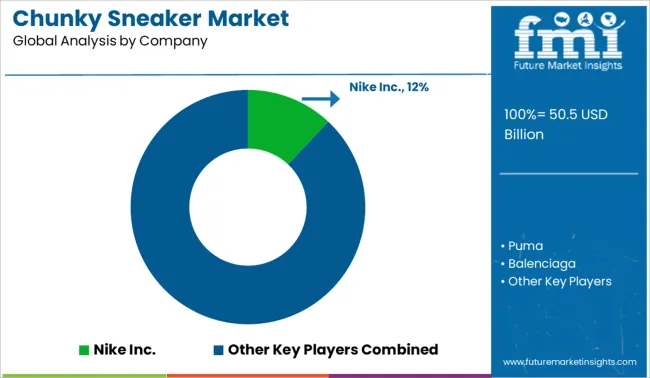
The running shoe industry is boosting its investments in cutting-edge items to meet consumer demands and provide them with specialized services. Through mergers and acquisitions, footwear producers also intend to broaden their product offering and geographic reach while providing consumers with footwear that is both value-added and reasonably priced.
This might be done through marketing, influencer campaigns, or more natural hashtag campaigns. In any case, the more you understand about the target demographic, the more effective your marketing will be.
For Instance:
| Attribute | Details |
|---|---|
| Forecast Period | 2025 to 2035 |
| Historical Data Available for | 2020 to 2024 |
| Market Analysis | USD Million for Value |
| Key Regions Covered | North America; Latin America; Europe; East Asia; South Asia; Oceania & Middle East and Africa(MEA) |
| Key Countries Covered | USA, Canada, Brazil, Mexico, Germany, United Kingdom, France, Spain, Italy, Russia, South Africa, Northern Africa GCC Countries, China, Japan, South Korea, India, Thailand, Malaysia, Indonesia, Australia, and New Zealand. |
| Key Segments Covered | Type, Waterproofing, Consumer Orientation, Price Range, and Region |
| Key Companies Profiled | Puma; Balenciaga; Louis Vuitton; Adidas; A.P.C.; Nike; Gucci; Fila; Champion; Topshop; Jeffrey Campbell; Sketchers; Ash; Treton; Off-White; Others |
| Report Coverage | Market Forecast, Company Share Analysis, Competition Intelligence, Drivers, Restraints, Opportunities and Threats Analysis, Market Dynamics and Challenges, and Strategic Growth Initiatives |
| Customization & Pricing | Available upon Request |
The global chunky sneaker market is estimated to be valued at USD 50.5 billion in 2025.
The market size for the chunky sneaker market is projected to reach USD 78.4 billion by 2035.
The chunky sneaker market is expected to grow at a 4.5% CAGR between 2025 and 2035.
The key product types in chunky sneaker market are road, treadmill, trail, mud and snow.
In terms of waterproofing, waterproof segment to command 58.1% share in the chunky sneaker market in 2025.






Our Research Products

The "Full Research Suite" delivers actionable market intel, deep dives on markets or technologies, so clients act faster, cut risk, and unlock growth.

The Leaderboard benchmarks and ranks top vendors, classifying them as Established Leaders, Leading Challengers, or Disruptors & Challengers.

Locates where complements amplify value and substitutes erode it, forecasting net impact by horizon

We deliver granular, decision-grade intel: market sizing, 5-year forecasts, pricing, adoption, usage, revenue, and operational KPIs—plus competitor tracking, regulation, and value chains—across 60 countries broadly.

Spot the shifts before they hit your P&L. We track inflection points, adoption curves, pricing moves, and ecosystem plays to show where demand is heading, why it is changing, and what to do next across high-growth markets and disruptive tech

Real-time reads of user behavior. We track shifting priorities, perceptions of today’s and next-gen services, and provider experience, then pace how fast tech moves from trial to adoption, blending buyer, consumer, and channel inputs with social signals (#WhySwitch, #UX).

Partner with our analyst team to build a custom report designed around your business priorities. From analysing market trends to assessing competitors or crafting bespoke datasets, we tailor insights to your needs.
Supplier Intelligence
Discovery & Profiling
Capacity & Footprint
Performance & Risk
Compliance & Governance
Commercial Readiness
Who Supplies Whom
Scorecards & Shortlists
Playbooks & Docs
Category Intelligence
Definition & Scope
Demand & Use Cases
Cost Drivers
Market Structure
Supply Chain Map
Trade & Policy
Operating Norms
Deliverables
Buyer Intelligence
Account Basics
Spend & Scope
Procurement Model
Vendor Requirements
Terms & Policies
Entry Strategy
Pain Points & Triggers
Outputs
Pricing Analysis
Benchmarks
Trends
Should-Cost
Indexation
Landed Cost
Commercial Terms
Deliverables
Brand Analysis
Positioning & Value Prop
Share & Presence
Customer Evidence
Go-to-Market
Digital & Reputation
Compliance & Trust
KPIs & Gaps
Outputs
Full Research Suite comprises of:
Market outlook & trends analysis
Interviews & case studies
Strategic recommendations
Vendor profiles & capabilities analysis
5-year forecasts
8 regions and 60+ country-level data splits
Market segment data splits
12 months of continuous data updates
DELIVERED AS:
PDF EXCEL ONLINE
Sneakers Market Analysis - Growth & Demand Forecast 2025 to 2035
Sneaker Boots Market Insights - Size & Forecast 2025 to 2035
Women Sneakers Market Growth - Demand & Trends 2025 to 2035
White Sneakers Market Insights - Size & Forecast 2025 to 2035
Men’s Sneakers Market Growth – Trends & Forecast 2022-2032
Leather Sneakers Market Growth - Trends & Forecast 2025 to 2035
Designer Sneaker Market Forecast Outlook 2025 to 2035
Lifestyle Sneakers Industry Analysis in United Kingdom Growth, Trends and Forecast from 2025 to 2035
Waterproof Sneakers Market Analysis - Growth & Forecast 2025 to 2035
Refurbished Sneaker Market Trends - Growth & Forecast 2025 to 2035

Thank you!
You will receive an email from our Business Development Manager. Please be sure to check your SPAM/JUNK folder too.
Chat With
MaRIA